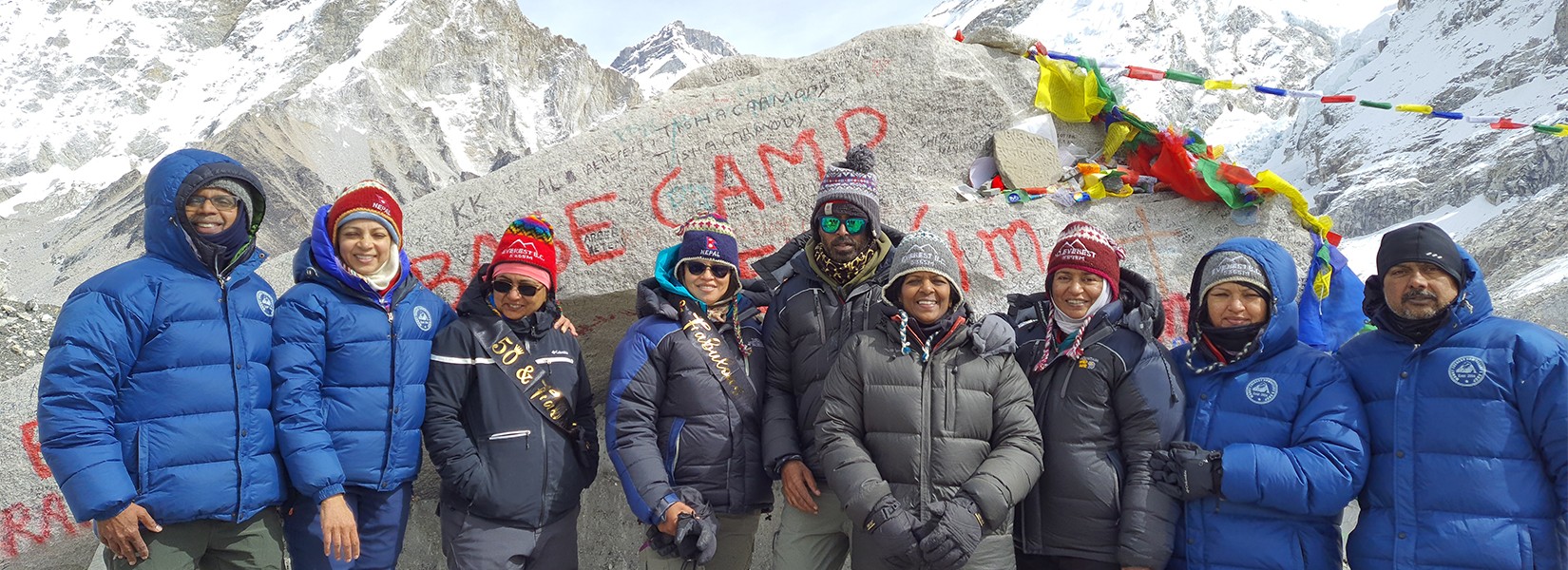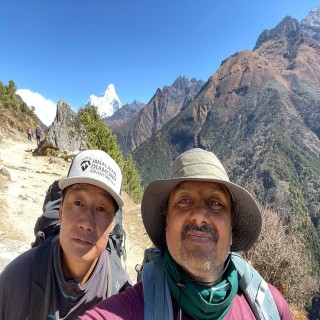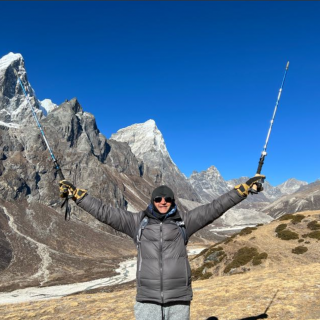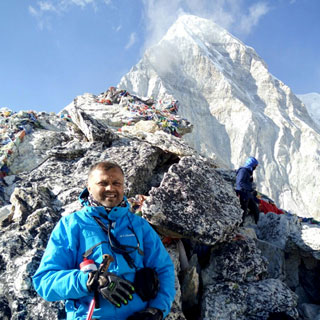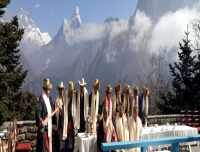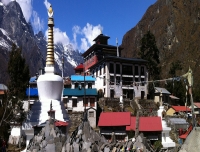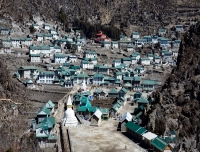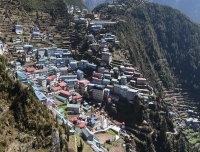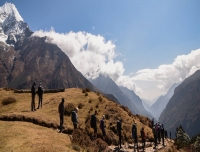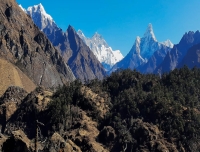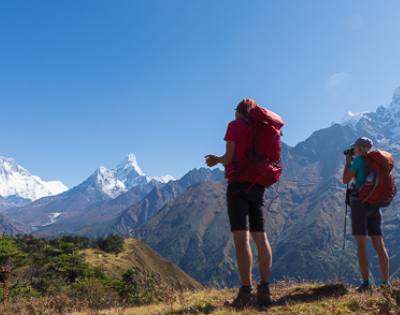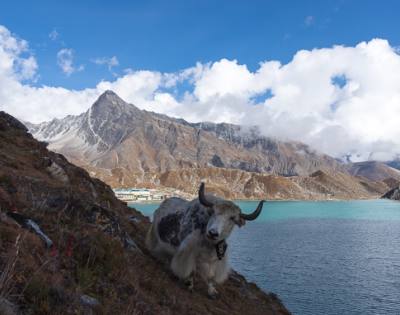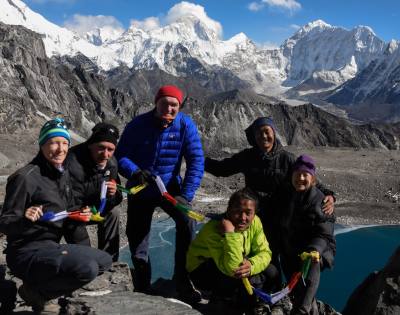- Read Reviews onTripadvisor
- Phone & WhatsApp Support+977 9851112535 (Chandra Shor)
Everest Base Camp Trek | 15 Days
Fact Information
- Duration
- 15 Days
- Destination
- Nepal
- Difficulty
- Moderate
- Accommodation
- Hotel & Lodges
- Activity
- Trekking
- Transportation
- Tourist Bus, Car, Jeep, Air-plane
- Meals
- BLD (Breakfast, Lunch and Dinner)
- Max Person
- 18
- Min Person
- 2
- Maximum altitude
- 5,550 meters, (18,208 ft)
- Best season
- September, October, November, April & May
About Trip
“Ultimate destination of the world for trekkers, hikers and mountaineers"
The Everest Base Camp Trek is a once-in-a-lifetime opportunity to explore the stunning Himalayan landscapes, experience the unique culture of the Sherpa people, and stand in awe of the world's highest peak, Mount Everest. The trek is an endurance test that will push you to your limits, but the rewards are well worth the effort - from the breathtaking mountain vistas to the unforgettable cultural immersion.
To reach the Everest region, trekkers and mountaineers often take a scenic mountain flight from Kathmandu or Ramechhap airport. Due to traffic congestion in Kathmandu Tribhuvan International airport (TIA), flights are sometimes diverted to Ramechhap. After a short flight, the trek kicks off in Lukla, and the route passes through colorful Sherpa villages, tea houses, cultivated farmlands, mani walls, stupas, significant gompas, meandering crystal-clear rivers, waterfalls, high suspension bridges, and forests with stunning views of snow-capped mountains.
The trek takes around 11-12 days to complete and offers an unforgettable experience for those who are up for the challenge. It is not just a physical challenge but also a journey of self-discovery and cultural immersion, where trekkers can experience the natural beauty, local culture, and unique lifestyle of the people living in the region. The trek takes place in the Sagarmatha National Park, which is home to various species of flora and fauna. A trek to the base camp of the world's highest peak combines the beauty of the Himalayas with the cultural heritage of the Sherpa people, making it a truly unforgettable experience for thousands of trekkers and mountaineers each year.
Trip Highlights
Views of Mount Everest: One of the main attractions of the trek is the chance to see the world's highest mountain up close. You will have several opportunities to admire the breathtaking views of Mount Everest, along with other iconic peaks like Lhotse, Nuptse, and Ama Dablam.
Trekking in the Solu-Khumbu region: The trek takes you through the Solu-Khumbu region of Nepal, which is known for its beautiful landscapes, rich culture, and diverse flora and fauna.
Interaction with the local Sherpa community: The trek offers the opportunity to interact with the local Sherpa people, learn about their way of life, and gain a deeper appreciation for their culture and traditions.
Exploring Sagarmatha National Park: The trek passes through Sagarmatha National Park, which is home to a diverse range of flora and fauna, including the elusive snow leopard, musk deer, and the Himalayan tahr.
Visit to Tengboche Monastery: The Tengboche Monastery is one of the largest and most important Buddhist monasteries in the Solu-Khumbu region, and a visit here offers a unique glimpse into the spiritual heart of the Sherpa people.
Scenic helicopter ride: For those who prefer not to make the entire trek on foot, a scenic helicopter ride can be arranged to take you from Lukla to Everest Base Camp, offering breathtaking views of the surrounding mountains.
Outlined Itinerary
Day 01: Arrival in KTM Tribhuvan international airport (1,350 m), transfers to Hotel included BB service.
Day 02: Drive to Ramechhap airport 135Kilomters 5hrs, Fly to Lukla, and trek starts to Phakding (2,610 m), 3hrs.
Day 03: Trek Phakding - Namche Bazar (3,440 m), 6/7 hrs.
Day 04: Hike to Everest view Hotel (3,870 m), for the best, Everest panorama view/
Day 05: Trek Namche - Tengboche Monastery (3,860 m), 5/6hrs.
Day 06: Trek Tengboche - Dingboche (4,410 m), 7hrs.
Day 07: Hike to Nangkartshang viewpoint (5,083 m), 3hrs.
Day 08: Trek Dingboche - Laboche (4,910 m), 5/6hrs.
Day 09: Trek Loboche - Gorapse (5,171 m), and at same day, hiking of Kalapathar (5,550 m) 6/hrs.
Day 10: Trek to Everest base camp (5,364 m), and trek back to Lobuche 6/7hrs.
Day 11: Switchback Pangboche (3,860m), 5hrs.
Day 12: Trek back to Namche (3440 m), 4/5hrs.
Day 13: Trek back to Lukla (2860m), 8hrs.
Day 14: Fly back to Ramechhap airport and drive to Hotel Thamel Moonlight 5hrs
Day 15: Valley sightseeing, Farewell dinner.
Day 16: Departure for home.
Detailed Itinerary
Day 01: Arrival in Kathmandu Airport 1,350 meters (4,429 ft), transfers to hotel.
Representatives from Himalayan Diamond Adventures will greet you upon your arrival at Tribhuvan International Airport in Kathmandu. You will be welcomed with a fresh flower garland, a traditional Nepali greeting, and then escorted to the hotel for bed and breakfast service. The drive from the airport to the hotel takes approximately 15 to 20 minutes, if there is no traffic jam on our way. After checking into the hotel, we will have a short refreshment meeting at the hotel. In the evening, the company will host a welcome dinner at a traditional Nepali restaurant, complete with a cultural dance performance, to celebrate the start of your trip. During the dinner, your guide will provide a brief overview of the schedule for the following day.
Accommodation: 3 to 5 Stars standard of Hotel .
Transportation: Tourist bus or car.
Meals: Welcome Dinner, Breakfast, and includes drinks.
Day 02: Fly to Lukla 2,840m (9,317 ft), trek begins to Phakding 2,610m (8,563 ft), 2. 3hrs.
Tomorrow morning, we will depart from Ramechhap airport with an early flight, so we will have to leave from the hotel in Kathmandu very early. The drive to Ramechhap airport will take approximately 5 to 6 hours, covering a distance of 135 kilometers.From Ramechhap airport, we will take a short but thrilling flight to Lukla Hillary airport, known for its high altitude of 2,860 meters and its short and narrow runway. After a short break in Lukla for final trip preparations, we will embark on our journey to Phakding. The trek will take us along a straightforward path, passing through beautiful Sherpa lands and religious sites with breathtaking landscapes. After 2 and a half to 4 hours of comfortable trekking, covering a distance of 7.5 km (4.6 miles), we will reach Phakding at an altitude of 2,610m (8,563 ft).
Maximum Elevation: 2,860m (9,383 ft).
Trekking hours: 2.5 hrs, 200m descent, 50m ascent.
Accommodation: Lodge.
Meals: Lunch, Dinner, Breakfast with hot drinks.
Day 03: Trek to Namche Bazar 3,440 meters (11,286 ft), 5-6 hours.
We will continue our mountain journey, following the Dudh Koshi River. The trail will lead us to Sagarmatha National Park through the Dudh Koshi River valley, passing many beautiful villages, restaurants, and guesthouses, as well as cultivated farm lands, waterfalls, and well-constructed suspension bridges over the Dudh Koshi River. As we trek through the village of Banker, we will have a stunning view of Kusum Kanguru (6,369 m) and Thamserku (6,623 meters). After 2 to 3 hours of slightly uphill trekking, we will reach Sagarmatha National Park, where we will need to present our permits and enter it. Today, we should have an early hot lunch before leaving the last settlement of Jorsalle. After leaving Jorsalle, there are no places to eat hot meals until we reach Namche Bazar. From Jorsalle, our trail continues straight ahead to the confluence of the Dudh Koshi and Bhote Koshi rivers, following the
Dudh Koshi River. Before starting the tiring uphill trail, we will cross the famous Hillary Bridge, the highest bridge over the Dudh Koshi River. We will trek for about 5 to 7 hours, covering a distance of 12.5 kilometers, with stunning landscapes throughout the journey from Phakding.
Elevation: 3,440 meters (11,286 ft).
Trekking hours: 5 hours, 10,00m ascent, 100m descent.
Accommodation: Lodge the attached bathroom.
Meals: B, L, D with hot drinks.
Day 04: Hike to Everest view Hotel 3,870m (12,697 ft), for panorama view.
Today is a rest day for us, it's very important to take a rest day after rapidly ascending a mountain. Even though we don't take a rest, we will hike to the Everest View Point (3,867m or 12,687ft) for the best panoramic view of Mount Everest and other beautiful mountain views. If we have time, we will visit Khumjung village, the Yeti Scalp Monastery, and the Mountain Museum in Namche Bazaar."
Overnight stay at a lodge in Namche Bazar.
Maximum elevation: 3,870m (12,697 ft).
Visit: Khumjung village and Hillary school.
Accommodation: Lodge.
Meals: Breakfast, Lunch, Dinner with hot drinks.
Day 05: Trek to Tengboche Monastery 3,860 meters (12,664 ft), 5 hours.
Today, we're on day three of our mountain trek to Tengboche Monastery (altitude of 3,860 meters). The hike will take about 5-6 hours, covering 9.2 km from Namche, surrounded by stunning mountain views. The trail starts with a difficult path above Namche Bazar, but quickly becomes easier with breathtaking views of Mount Everest, Lhotse, Thamserku, and Amadablam. After a relaxing hike along the Kyangjuma valley and a break for lunch at Phunge Thanga, the trail becomes challenging from the Armi checkpoint area until Tengboche Monastery. The hike is difficult, but more enjoyable in April to May when rhododendron flowers bloom. This evening, we will visit the significant Tengboche Monastery.
Maximum Elevation: 3,860 meters (12,664 ft).
Trekking hours: 4 to 5 hours, 350m descent, 750m ascent.
Accommodation: Lodge.
Meals: Breakfast, Lunch, Dinner with hot drinks.
Day 06: Trek to Dingboche village 4,410 meters (14,468 ft), 5 hours.
Today we will trek to Dengboche village, the last major settlement before EBC, in a 6-7 hour hike covering 6.5 miles (10.5 km). We will start with a slight descent through a forest of silver pines, birches, and rhododendrons with magnificent views of Everest, Lhotse, and Amadablam and cross the Imja Tse stream on a high suspension bridge. After crossing the bridge over the Imja river, the trail ascends slightly to Pangboche village with a breathtaking view of Mount Amadablam. We will stop for lunch at Somare. After lunch, we will continue on an off-the-beaten trail with a gradual ascent to Dingboche village, our final destination with stunning views of Lhotse and Lhotse Shar.
Maximum Elevation: 4,410 meters (14,468 ft).
Trekking hours: 4 to 5 hours, 70 descent, 580m ascent.
Accommodation: Lodge.
Meals: Breakfast, Lunch, Dinner with hot drinks.
Day 07: Acclimatization Day, hike to Nangkartshang viewpoint 5,083 meters (16,676 ft), 3 hours.
Today is our designated rest day. It's crucial to take a break after quickly ascending in the mountains. If we choose not to rest, we will climb Nangkartshang Hill for 360-degree views of the surrounding peaks, which is also good for acclimatization. From the top, we will see breathtaking views of Island Peak, the most popular peak in the region, and Mount Makalu, located in the distance. After admiring the views, we will return to T-House for a hot lunch and rest.
Maximum Elevation: 5,083 meters (16,676 ft).
Hiking hours: 4 hours, 400m ascent.
Accommodation: Lodge.
Meals: Breakfast, Lunch, Dinner with hot drinks.
Day 08: Trek to Labuche 4,910 meters (16,108 ft), 5 hours.
Today, on our two-day stay in Dingboche, we will trek to Lobuche, which is located at an altitude of 4,910 meters. The trek will pass through wide Yak and horse grazing lands, yak herders' huts above Pheriche village, and a small Khumbu Glacier's milk river. Before starting the strenuous uphill trail, we will stop at Thukla Sherpa village to refill our energy. We will also see chortens built in memory of those who lost their lives in attempts to climb Mount Everest and Lhotse peak. Today's hike will take 5-6 hours and cover a distance of 10.7 km, ending in Lobuche where we will check into our rooms for some rest. Afterwards, we will hike to the Khumbu glacier viewpoint.
Maximum Elevation: 4,910 meters (16,108 ft).
Trekking hours: 4 to 5 hours, 500m ascent.
Accommodation: Lodge.
Meals: B, L, D with hot drinks.
Day 09: Trek to Gorapse the last settlement 5,171 meters (16,965 ft), 6hrs.
Today we will trek from Lobuche to Gorapshe, following the Khumbu glacier ridge and passing through stones, gravels, and moraines. The trail takes a slightly uphill direction, but offers exciting views along the way. After a slow hike of 3 to 4 hours, covering a distance of 2.8 miles / 4.5 kilometers, we will reach Gorapse village, the last permanent settlement on the EBC trail. After a hot meal in Gorapse, we will hike to Kalapathar, 5550 meters, for a beautiful sunset view of the mighty Mount Everest. Is it correct sentences? Can you correct me?
Maximum Elevation: 5,550 meters (18,208 ft).
Hike: Kalopathar for the best Everest view.
Trekking Hours: 6 to 7 hours, 250m ascent.
Accommodation: Lodge.
Meals: B, L, D with hot drinks.
Day 10: Everest base camp 5,364m (17,598 ft), trek back to Lobuche, 8hrs.
Today is the final day of our EBC trek, as planned. We will reach the Everest Base Camp by trekking along the moraine on the edge of the Khumbu glacier. The trail ahead is slightly uphill and rugged, but it offers a stunning view of the mountains and glacier. After about 2 to 3 hours of trekking, covering a distance of 4.5 miles or 7.2 kilometers, we will reach the Everest Base Camp. There we will see rock cairns and prayer flags fluttering in the wind. If we are trekking during the spring season, we may encounter many climbers and see a colorful array of tents throughout the base camp. After taking a few moments to enjoy and reflect on our successful trip, we will return to Gorapse via the same trail. We will then have a hot lunch and continue our descent to Lobuche.
Maximum Elevation: 5,364 meters (17,598 ft).
Trekking hours: 8 hours,
Back trek: to Lobuche 3 hours,
Accommodation: Lodge:
Meals: B, L, D with hot drinks.
Day 11: Switchback Pangboche village 8hrs via the same way.
Today we trek back to Pangboche village with splendid Mount views.
Elevation: 13,074 feet (3,985 m)
Trekking hours: 5hours,
Accommodation: Lodge with a well-attached bathroom.
Meals: Breakfast/ Lunch/Dinner with hot drinks.
Day 12: Trek back to Namche bazar 3,440 meters.
Today we trek back to Manche bazar via same trail with wonderful EBC trekking experience.
Elevation: 3,440 meters (11,286 ft).
Trekking hours: 6 hours,
Accommodation: Lodge the attached bathroom.
Meals: B, L, D with hot drinks.
Day 13: Trek back to Lukla the final EBC trekking ending point.
After a successful EBC trek, we will trek back to Lukla, the final destination of our trekking adventure in the Everest region. We will celebrate our successful trip this evening with our guide and porters, including drinking and dancing. We will create lifetime memories together.
Elevation: 2,860 meters (9,383 ft).
Trekking hours: 8 hours,
Accommodation: Lodge.
Meals: Breakfast/ Lunch/ Dinner with hot drinks.
Fay 14: Fly back to Ramechhap airport and drive to Kathmandu 135 meters, transfer to the hotel.
Elevation: 1,350 meters (4,429 ft).
Transportation: Aeroplan/ Tourist bus/ Car.
Accommodation: 3 to 5 Stars standard of Hotel in Kathmandu.
Meals: Breakfast.
Day 15: Valley sightseeing to UNESCO world heritage site.
Today, after breakfast, we will embark on a journey to explore some of the popular landmarks and milestones in the Kathmandu Valley, including several UNESCO World Heritage sites such as Pashupatinath Temple, Boudhanath Stupa, Patan Durbar Square, Swayambhunath Stupa, and Bhaktapur Durbar Square.
Kathmandu is widely known as the city of temples and a cultural hub in Nepal. These places that we will visit today showcase the cultural and religious diversity of Nepal. Pashupatinath Temple is one of the
oldest Hindu temples dedicated to Lord Shiva. Both Boudhanath and Swayambhunath are important sites for Buddhism and are visited by both Hindu and Buddhist followers. These places display the unique architecture, religious tolerance, and diversity that can be found in Nepal.
Transportation: Private vehicle service.
Permits: Entry Permits of Patan, Bhaktapur, and Kathmandu.
Accommodation: 3 to 5 Stars standard of Hotel.
Meals: Farewell Dinner and Breakfast.
Day 16: Departure for home.
16th day of the tour, we will escort you to the Tribhuvan International Airport in a private vehicle before your airport checking time.
Transportation: Private vehicle service.
Meals: Breakfast.
Note: - that the outlined itinerary is designed for those who prefer a full package service. However, we understand that preferences and time constraints may vary, so we offer the flexibility to customize the itinerary according to your needs. The selection of itineraries and staff will be based on your specific requirements and budget. Additionally, we have options available for partial visits to accommodate your preferences and financial situation.
Cost Details
What's included
| 1 Member | 2 Members | 3 Members | 4 Memebers | 5 Members | 6 Memebers |
| USD 2303 | USD 1668 | USD 1595 | USD 1450 | 1530 | 1365 |
| EUR 2,140 | EUR 1,550 | EUR 1485 | EUR 1,350 | EUR 1,420 | EUR 1,270 |
- 1. Private vehicle for airport pickup and drop-off according to your itinerary.
- 2. A three-night stay in deluxe accommodation at Hotel Moonlight or Kathmandu Guest House in Thamel, Kathmandu, including breakfast as part of the package.
- 3. Private car transportation from Kathmandu to Ramechhap airport and back.
- 4. Flight fares for Ramechhap/Lukla/Ramechhap, including 15kg of luggage cargo.
- 5. A daily menu of your choice, providing three meals a day (breakfast, lunch, and dinner), along with fresh fruits. Hot drinks such as tea, coffee, ginger lemon tea, ginger lemon honey, hot chocolate, milk tea, milk coffee, and hot water are also available during the trip.
- 6. Comfortable teahouse accommodations during the trek, with private Western toilets in Lukla, Namche, Dingboche and Pheriche.
- 7. Inclusion of entry permits: Sagarmatha National Park fee and Pasang Lhamu Municipality fee.
- 8. Private car transportation for domestic and international airport transfers.
- 9. A one-day valley sightseeing tour including Pashupatinath, Boudhanath, and Swayambhunath, with all temple entry fees covered. A city guide and transportation are also provided.
- 10. An experienced, knowledgeable, and friendly English-speaking guide with a government license, including all expenses for salary, food, drinks, accommodation, transport, and insurance.
- 11. Assistance guide service, depending on the group size and requirements.
- 12. One strong and helpful porter assigned to every two members, equipped with proper gear including a Gore-Tex jacket/trousers, trekking shoes, woolen hat, woolen gloves, woolen socks, sunglasses, etc.
- 13. Insurance coverage for Nepalese staff, including emergency rescue evacuation by helicopter, hospitalization, medical treatment, and accidents.
- 14. Availability of medical supplies, including a first aid kit. Oximeter readings of pulse, oxygen saturation, and heart rate taken twice daily to monitor Altitude Mountain Sickness (AMS) symptoms.
- 15. Arrangement of Emergency Helicopter service, with the cost covered by your Travel Insurance company.
- 16. Complimentary items from the company: a duffle bag, map, and company T- shirt.
- 17. Hot bag services.
- 18. Inclusion of government taxes and official expenses.
- 19. Entry fees for UNESCO heritage sites.
- 20. Rental services available for down-filled jackets, sleeping bags, mini crampons, and trekking poles. A fee of $5 per day for laundry service and maintenance.
- 21. Welcome dinner and farewell dinner at Nepali cultural restaurants.
What's not included
- ❖ Personal trekking equipment and gears.
- ❖ Nepal entry visa fee.
- ❖ International airfare bill.
- ❖ Extra night accommodation in Kathmandu because of early arrival, late departure, early return from mountain (due to any reason) than the
- ❖ Meals while you stay in Kathmandu Hotel Lunch and Dinner.
- ❖ Your travel insurance policy should be covered rescue evacuation, medical treatment and accidental.
- ❖ Any entry fee for the temple or monastery.
- ❖ Donations or charity.
- ❖ Your personal expenses like; Hot shower, Laundry, Battery charging, telephone, WIFI, and shopping, etc.
- ❖ Alcoholic and non-alcoholic alcoholic hot and cold drinks.
- ❖ Tips for the guide, porter, and driver (tipping is expected)
Map
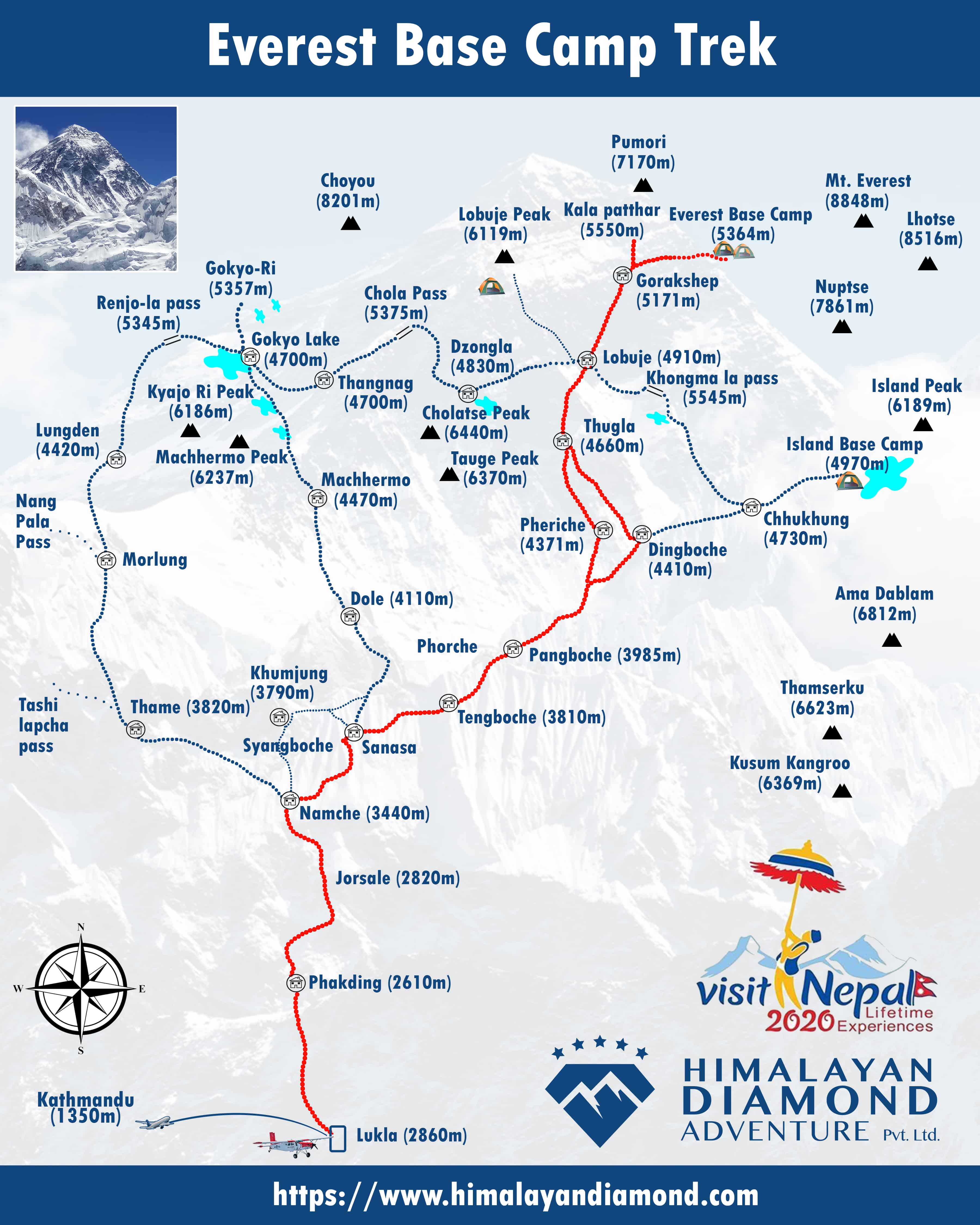
Client Review
Useful Info
What Essential Documents Do I Need To Bring With Me On Tour?
When going on a tour, it's important to bring essential documents to ensure a smooth and hassle-free trip. Here are some documents that we highly recommend you bring with you.
Passport: When traveling to a foreign country, it is important to ensure that you have a valid passport with at least 6 months validity remaining before its expiration date and at least 2 blank visa pages. This is because many countries require that your passport is valid for at least six months beyond your expected departure date and has sufficient blank pages for visa stamps and entry/exit stamps.
Visa: Depending on your destination, you may need a visa to enter the country. Check with the embassy or consulate of the country you're visiting to see if you need a visa. Visit the official website of the Department of Immigration of Nepal at https://www.immigration.gov.np/page/tourist-visa
Travel itinerary: It's always a good idea to have a printed copy of your travel itinerary, including flight and hotel reservations, tour bookings, and any other important travel plans.
Travel insurance: As a traveler, it is advisable to purchase a comprehensive travel insurance package that covers potential medical issues, personal accidents, emergency helicopter evacuation, loss or damage of personal belongings, and trip cancellations, especially if you are planning to trek to high altitudes up to 5,500 meters, such as Everest Base Camp. It is also important to ensure that the insurance covers the cost of cancellation for both your international flight and the trek. The minimum recommended coverage amount is USD 100,000. Many insurance companies offer travel insurance services online, so you can easily find a plan that meets your needs.
COVID-19 vaccination certification: To obtain a Nepal tourist visa during the ongoing pandemic, travelers need to show either a completed COVID-19 vaccination certificate with a QR code or a negative PCR test result taken within 72 hours of boarding.
Health documents: If you're traveling to a country with specific health requirements, such as a yellow fever vaccination, make sure to bring the necessary health documents.
Driver's license: If you plan on driving while on tour, make sure to bring your driver's license.
Credit cards and cash: Bring enough cash and credit cards to cover your expenses while on tour.
Emergency contact information: Write down the contact information for someone you trust in case of an emergency. This could include a family member, friend, or employer.
It's always a good idea to make copies of all your important documents and keep them in a safe place in case the originals get lost or stolen. Additionally, you may want to consider using a travel document organizer to keep all your important documents organized and easily accessible.
If you are traveling to Nepal, then here are some essential documents you will need to have with you in order to ensure a smooth and hassle-free trip.
What Essential Documents Do I Need To Bring With Me For EBC Tripr?
❖ Valid passport with at least 6 months validity and at least 2 blank visa pages
❖ Travel insurance policy document
❖ Photocopies of your passport's personal information page
❖ One or more recent passport-sized photos with a white background (1.5 inch x 1.5 inch)
❖ Completed and signed Nepal visa application form
❖ Proof of accommodation in Nepal (such as a hotel reservation or address)
❖ Valid return flight or travel ticket
❖ Proof of sufficient financial means, such as recent bank statements
❖ Mastercard, Visa, and some cash in USD
❖ Proof of payment of the Nepal visa fee
❖ To obtain a visa for Nepal, your passport must be valid for at least 6 months from the travel date and you must present either a completed COVID-19 vaccination certificate with QR code or a valid PCR test negative result taken within 72 hours prior to boarding.
How to apply for an online tourist visa to Nepal?
Visit the official website of the Department of Immigration of Nepal at https://www.immigration.gov.np/page/tourist-visa
1. Fill out the online application form with your personal information, including your name, date of birth, nationality, passport number, and intended travel dates.
2. Upload a recent passport-size photograph in JPEG or PNG format.
3. Pay the visa fee online using a credit card or debit card. The cost of the visa depends on the length of your stay in Nepal, but it typically ranges from $30 to $125.
4. Once you have submitted your application and payment, you will receive a confirmation email with a receipt and an application ID.
5. After your application has been processed, you will receive another email with a link to download your visa. You should print out the visa and carry it with you when you travel to Nepal. It's important to note that the online tourist visa is valid for multiple entries and is valid for 15, 30, or 90 days, depending on your length of stay. Also, be sure to apply for your visa well in advance of your travel date to allow time for processing.
What Type Of Insurance Should I Get?
It is essential for foreign travelers to secure insurance coverage while trekking or climbing in Nepal. Although trekking in Nepal is generally safe, travel insurance is compulsory for mountaineering activities in Nepal. The trip can pose physical challenges and hazards, particularly at high altitudes where altitude sickness is prevalent among trekkers and climbers, especially those who have not acclimatized properly. Physical injuries can also occur on mountain trails or during climbing activities, and in emergency situations, foreign trekkers or climbers may need to be rescued by helicopter and transported to hospitals in Kathmandu, which can be costly if the traveler does not have insurance coverage.
We strongly recommend purchasing a travel insurance package that covers high altitudes up to 5,500 meters, potential medical issues, natural disasters, personal accidents, emergency helicopter evacuation, loss or damage of personal belongings, and trip cancellations. The minimum recommended coverage amount is USD 100,000. There are many insurance companies that offer travel insurance services online. You should compare plans to find the one that best meets your needs.
What Are Some Popular And Highly Rated Travel Insurance Companies?
If you are in search of popular and highly-rated travel insurance companies, then we can recommend some based on positive feedback we have received from our previous travelers. It is here. [Company 1], [Company 2], [Company 3]............................
For Travelers from USA and CANADA........................
Online Global Health Insurance
Travelex
Insure My Trip.com (Online Insurance Aggregator)
Mondial Assistance
Access America
HCC Medical Insurance Services
Good Neighbor Insurance (International Health)
International Health
Insuremytrip dot com
MultiNational Underwriters
TIC Travel Insurance Coordinators Ltd
Travel Assist
TraveLite
For Travelers from England...................................
Specialty Group (UK) Limited
FirstAssist Services Limited
Harrison Beaumont
Buy cheap travel insurance
For Travellers from EUROPE and SLOVENIA...........................
Assistance CORIS
For Travellers from AUSTRALIA and NEW ZEALAND
Cover More Travel Insurance
CGU Insurance Limited
For Travellers from SOUTH AFRICA........................................
Travel insurance Consultants Pty. Ltd.
What is the weather like in Nepal and what are the average temperatures?
As Nepal's topography is divided into three geographical regions - Terai, Hills, and Mountains - each region experiences different temperatures during different seasons. Below is a tabular illustration of temperature changes throughout the different seasons in Nepal, which will allow you to better understand the changing weather conditions.
Seasons Minimum temperature (approx) Maximum temperature (approx) Weather Condition
Spring 4°C/ 39°F (Mountain) 20°C/ 68°F (Mountain) Moderate with occasional rain
Summer 12°C/ 53°F (Mountain) 25°C/ 77°F (Mountain) Extreme high with heavy rain
Autumn 3°C/ 37°F (Mountain) 18°C/ 64°F (Mountain) Moderate
Winter 10°C/ 50°F (Terai) -4°C/ 24°F (Mt.) 20°C/ 68°F (Terai) to 12°C/ 53°F (Mountain) Extreme low
What Is The Best Time To Trek In Nepal?
After a thorough analysis of all the seasons, it has been suggested that autumn is the best time of the year to trek in Nepal. The mild temperatures from September to November make the trekking experience more enjoyable. During this time of the year, trekking routes throughout the country are jam-packed with travelers from all around the world.
However, as mid-December is generally the holiday season in most countries, including the United States, there is a spike in the number of international tourists during early winter as well. Interestingly, to make the holiday season even more special, travel companies offer some of the best holiday destination packages during this time. So, be sure to take advantage of the best travel opportunities with the assistance of Himalayan Diamond Adventure.
Nonetheless, if you cannot make it in autumn, spring also allows for favorable conditions for trekking in Nepal. The warmer days and nights, lush plants and vegetation, and clear trekking trails during spring make the trek worthwhile. However, the downside is occasional rain and slightly higher temperatures in the lower elevations. All in all, after autumn, spring is the second-best time to trek in Nepal.
Best time to trek in Nepal:
Thousands of tourists visit Nepal every year to enjoy the picturesque nature and trek through the adventurous and diverse terrain. However, the best times to trek in Nepal are autumn (September to November) and spring (March to May). During these seasons, travelers are blessed with moderate temperatures and enjoyable weather conditions throughout the country.
As calm as it may seem, the challenging terrains of the Himalayas in Nepal can present trekkers with gruesome scenarios during harsh weather conditions. To avoid any unforeseen situations and to enjoy nature at its best, most trekkers prefer autumn for backpacking. However, it may not be the best time of the year to trek in Nepal for everyone. Some may prefer off-season trekking to avoid the crowds. Therefore, exploring the various seasons can help you choose a favorable time for trekking in Nepal based on your preferences.
Trekking Seasons in Nepal
Throughout the year, the landscape of Nepal experiences four seasons, each with its own uniqueness that brings significant changes to the natural environment. Below are some detailed insights into the four seasons in Nepal.
1. Spring Season (March-May)
Spring in Nepal lasts from March to May and is one of the preferred seasons for trekking throughout the country. During this time, the climate is moderate, with slightly higher temperatures reaching up to about 32°C (89°F) in the lower elevation regions and around 20°C (68°F) at higher altitudes. The sky is usually clear with mild days and occasional rain.
Spring brings a rejuvenation of nature. Flowers begin to blossom, trees become lusher with newly sprung leaves, and spring vegetation sprouts again. Likewise, the flora and fauna of the Himalayan terrain also resuscitate from the harsh winter. Overall, spring is considered a great time for trekking in Nepal due to the alluring freshness of nature.
2. Summer Season (June-August)
With the end of May, summer starts in Nepal and lasts from June to August, which is also the monsoon season in the country. During these months, the weather can be harsh, with scorching heat and heavy rain throughout the nation. The rising humidity and extreme hot weather conditions may restrict travelers from fully enjoying their trip.
Although the lower elevation regions experience harsh summers, the Himalayan terrains are not as brutal. In the mountain regions, temperatures can range from approximately 25°C to 12°C (77°F to 53°F). However, heavy rains can make trekking through rocky mountain terrain challenging, and the cloudy sky may obscure mountain views.
3. Autumn Season (September-November)
With the arrival of autumn from September to November, Nepal becomes a popular destination for trekking. During this season, the weather is usually pleasant with clear skies, moderate temperatures, and gentle sunshine throughout the day. However, early autumn may bring occasional light rainfall. As the season progresses into October and November, the monsoon season completely ends, and cooler weather conditions prevail.
Many people choose to trek to popular destinations such as Everest Base Camp, Annapurna Base Camp, and Poon Hill during this season. Additionally, autumn is festival season in Nepal, and visitors can witness major celebrations such as Dashain and Tihar, which provide an opportunity to experience Nepali culture and traditions. Many travel packages are available for the best treks in Nepal during this season, and our travel experts can help you plan your trip to align with the festival season.
4. Winter Season (December-February)
Winter, which lasts from December to February, is the harshest season for trekking in Nepal. As the temperature drops in December, nights become chilly, and temperatures can reach around 9°C (48°F) during the day and below 0°C (32°F) during the night in higher altitudes. During peak winter, many high passes and trekking routes in the mountains are covered with dense fog and snow, increasing the risk of unexpected accidents.
Because of the risks of unpleasant trekking conditions, most travelers avoid trekking in the Himalayan terrains during the winter season. Additionally, most expeditions and mountain climbing, including trekking in the Everest region, also come to a halt during the harsh winter. Overall, it may not be the best time to trek due to the challenges presented by the weather conditions.

